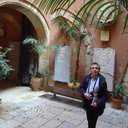Antiproliferative effect of antioxidant polyphenols from grape in murine Hepa-1c1c7.
Keywords
Abstract
BACKGROUND
Grapes and wine contain high concentrations of polyphenolic compounds. Although their cancer protective effect has been well documented, their activity as anticarcinogens should be cautiously considered since the molecular bases of action and their applicability to human cancer prevention are still unclear.
OBJECTIVE
We studied the antioxidant/antiradical activity and the antiproliferative effect in vitro of different polyphenolic mixtures, extracted from grapes and fractionated through RP-HPLC.
METHODS
The polyphenolic fractions were chemically characterized and their antioxidant/antiradical activity was determined by the DPPH assay. Mouse hepatoma Hepa-1c1c7 cells were used to study the cell growth inhibition capacity of these fractions by MTT assay. Their capacity of altering cell cycle and possible induction of apoptosis was examined using FACS analysis.
RESULTS
The original polyphenolic fraction OW, which contained gallic acid (GA), (+)-catechin (Cat), (-)-epicatechin (Ec), glycosylated flavonols (F) and procyanidin oligomers was fractionated into fraction I, composed of monomers and small oligomers, and fraction II that included flavonols and procyanidin oligomers of higher molecular weight. The three polyphenolic fractions tested showed quite similar antiradical activity, although fraction I was the most potent antiradical agent (lowest ED(50) value: 9 microg). Fraction II was the least potent cell growth inhibitor (highest IC(50) value: 100 microg/ml) but showed the strongest effect on the cell cycle of Hepa-1c1c7, inducing apoptosis in those cells. The original fraction OW was demonstrated to have the most potent cell growth inhibition effect (lowest IC(50) value: 43 microg/ml). However, it only appeared to alter cell cycle of Hepa-1c1c7 at concentrations higher than its IC(50) and did not induce apoptosis in those cells. A similar effect on cell cycle and apoptosis was encountered for fraction I.
CONCLUSIONS
The polyphenolic fractions tested in this study were potent antiradical agents and exerted an antiproliferative effect in mouse hepatoma Hepa-1c1c7 cells; the fraction with the highest degree of polimerization and galloylation (fraction II) had the most influence on the cell cycle and induction of apoptosis on Hepa-1c1c7.



